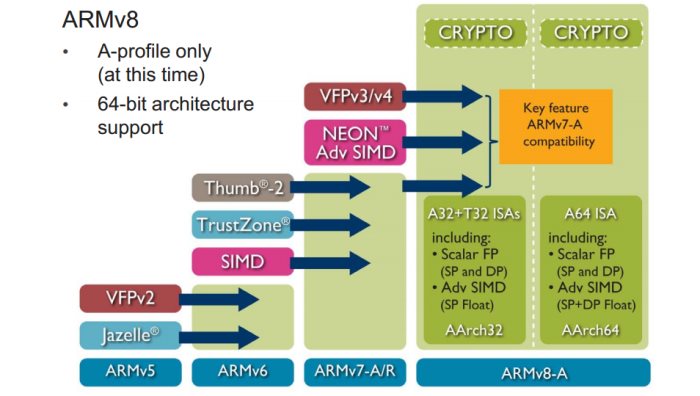64-Bit Exynos 5433 Confirmed, Will Only Run In 32-Bit Mode On Galaxy Note 4
According to some leaked source code, Samsung's Exynos 5433 chip (the one that will run inside the international version of the Galaxy Note 4) will be an ARMv8/64-bit chip. That's the good news; the bad news is that the chip will be running in 32-bit mode only, at least for now.
The leak shows that the SoC will include four 1.3 GHz Cortex A53 cores, four 1.9 GHz Cortex A57 cores and a brand-new Mali-T760 GPU. The CPU is what we've come to expect from Exynos chips so far; it's a big.Little setup that uses the lower-end and more power-efficient Cortex A53 cores (which are successors to Cortex A7) for simpler tasks and the Cortex A57 cores (successors to Cortex A15) for more complex tasks.
The CPU is built on the 20nm process and also benefits from Cortex A50-series improved power consumption, so it could be much more efficient than some of the latest Exynos chips while also delivering higher performance.
The Mali-T760 GPU is ARM's latest and supports up to 16 cores, although according to the leak this one is likely to support only eight cores, each clocked at 700 MHz. (It wouldn't be the first time Samsung used fewer cores than the maximum allowed for its GPUs.)
The 16-core version might come in a future Galaxy S6 or Galaxy Note 5. ARM has said before that Mali-T760 has a peak performance of 380 Gflops, which would rival Tegra K1's 365 Gflops, but it's likely that only the 16-core version will achieve that kind of performance.
The new GPU also supports the latest OpenGL ES 3.1 graphics API. The chip's driver will likely support the Android Expansion Pack for enhanced graphics, too, once Samsung upgrades Galaxy Note 4 and other future devices using this chip to Android L.
While Exynos 5433 will benefit from some of the architectural improvements of the ARMv8 instruction set, it seems the chip will only work in 32-bit mode. ARMv8 includes both 32-bit and 64-bit modes, but Samsung appears to have chosen to use only the 32-bit one for now.
Get Tom's Hardware's best news and in-depth reviews, straight to your inbox.
There are two theories for why the company might have done this. One is that the Galaxy Note 4 will arrive with Android 4.4 and not Android L, which is the only version of Android that supports 64-bit platforms. The other is that the U.S. version of the Galaxy Note 4 will only ever be 32-bit, because Qualcomm's Snapdragon 805 is an ARMv7 chip, and Samsung didn't want its U.S. customers to become frustrated that the Galaxy Note 4 model they are buying isn't 64-bit like the international one.
We'll see which theory is true when the Galaxy Note 4 receives the Android L update. If the international version continues to eschew the 64-bit mode -- despite fully supporting it after the update -- then we'll know Samsung just didn't want its U.S. customers to feel left out.
Follow us @tomshardware, on Facebook and on Google+.
Lucian Armasu is a Contributing Writer for Tom's Hardware US. He covers software news and the issues surrounding privacy and security.
-
wurkfur I would only buy a Qualcom phone anyways with how difficult it is to find good working roms on the exynos phones.Reply -
fuzzion No reason to upgrade to the note 4 when my note 3 is already and still 2 years ahead of the iphone 6.Reply
Samsung, surprise me with the note 5. -
Ninjawithagun This is just one more reason NOT to upgrade to the Note 4. The Note Edge intriqued me for sure, but is not quite enough to make me upgrade from my Note 3. Looks like I'm with fuzzion...Samsung, get your head out of the sand and INNOVATE!!!! A 64-bit processor should have been priority #1 with the Note 4 and Note Edge. MAKE IT HAPPEN!Reply -
bluestar2k11 "A 64-bit processor should have been priority #1 with the Note 4 and Note Edge. MAKE IT HAPPEN!"Reply
Why?
What possible benefit will a 64bit chip bring to phones?
I could think of a half dozen other things that would be a much better 1st priority.
Like battery life. -
ap3x Am I the only one that finds it hilarious that this thread sits here for a couple days now and only has 4 posts. Where are all the Samsung/Androiders. Pretty much crickets. If this where Apple this thread would light up like a Christmas tree.Reply
-
ap3x "No reason to upgrade to the note 4 when my note 3 is already and still 2 years ahead of the iphone 6.Reply
Samsung, surprise me with the note 5."
I realize you are passionate about your phone and it is a nice device for sure but lets not mix up the fact that you had a larger screen 2 years prior to the iPhone 6 with the idea that somehow that made your phone ahead. You can't even talk about NFC when the adoption is widely considered a failure and took Google Wallet down with it.
I am not even sure Apple Pay will work unless Apple partners with card providers (which they are doing) to adopt their solution. -
canadianvice Battery life will win the war, not spec dumping.Reply
Personally, the only Android anyone should really consider unless they do want an mSD or massive screen is the Nexus line. -
therealduckofdeath canadianvice, I think you're the only person in the universe ever to question the battery stamina of a Galaxy Note phone. :DReply -
wurkfur Reply14192344 said:"No reason to upgrade to the note 4 when my note 3 is already and still 2 years ahead of the iphone 6.
Samsung, surprise me with the note 5."
I realize you are passionate about your phone and it is a nice device for sure but lets not mix up the fact that you had a larger screen 2 years prior to the iPhone 6 with the idea that somehow that made your phone ahead. You can't even talk about NFC when the adoption is widely considered a failure and took Google Wallet down with it.
I am not even sure Apple Pay will work unless Apple partners with card providers (which they are doing) to adopt their solution.
Finally offering HD resolutions
Finally offering a decent screen size
Finally offering NFC which can be used for more than just payments.
Jobs is dead, and Apple is going to be on the same path if they don't get back to innovating. There is NOTHING about the new Iphone that is new and exciting. Wait until the hipsters find something else.
Samsung offers all kinds of designs and styles. It took Apple almost a decade to do the same instead of just offering a new model and continuing to sell the previous 1 or 2.
-
Ninjawithagun Reply14192171 said:"A 64-bit processor should have been priority #1 with the Note 4 and Note Edge. MAKE IT HAPPEN!"
Why?
What possible benefit will a 64bit chip bring to phones?
I could think of a half dozen other things that would be a much better 1st priority.
Like battery life.
Actually, battery life on my Note 3 is great! I can go 2 and sometimes 3 full days of light to moderate use before having to recharge the battery. On those days that I watch a lot of YouTube videos, I have to recharge after one day of use. Battery life can always be better, but until the industry advances forward with new battery technology, we are stuck with lithium-ion.

